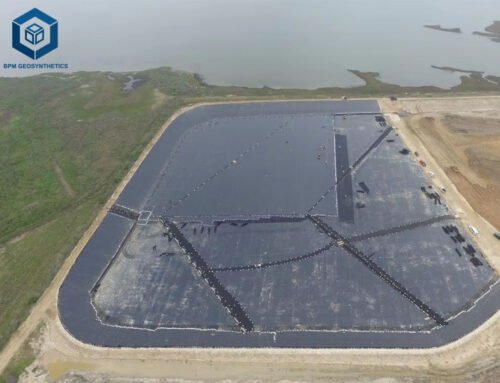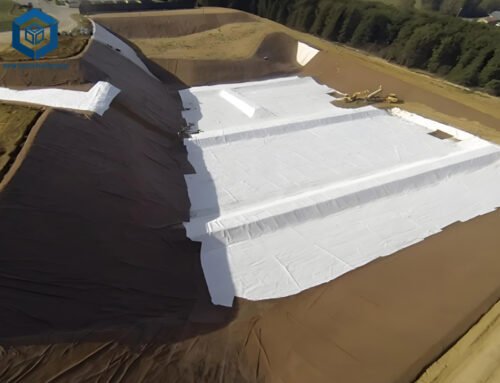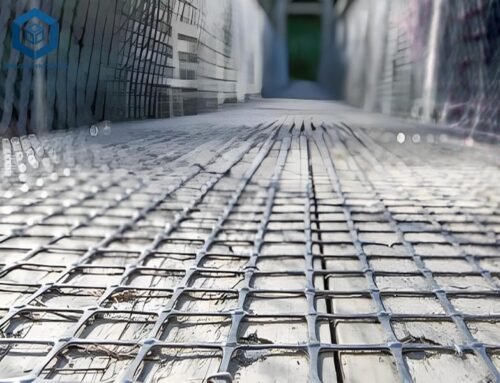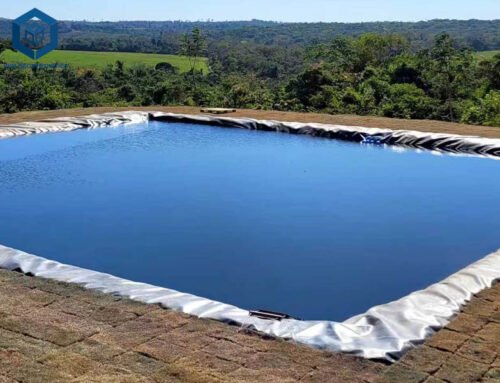Plastic pond liners are essential components in modern water containment systems, offering a reliable and cost-effective solution for preventing water seepage in various applications, from ornamental garden ponds to large-scale aquaculture and wastewater treatment projects. As global demand for efficient water management grows, the pond liner market is projected to reach USD 2.5 billion by 2030, with a CAGR of 6.2% from 2024, driven by increasing needs in residential, commercial, and industrial sectors. These liners, typically made from synthetic materials like High-Density Polyethylene (HDPE), Polyvinyl Chloride (PVC), or Reinforced Polyethylene (RPE), provide an impermeable barrier that ensures water retention, environmental protection, and structural integrity. This comprehensive guide explores the definition, types, specifications, applications, and benefits of plastic pond liners, providing detailed insights supported by industry data to help homeowners, engineers, and project managers make informed decisions. By understanding plastic pond liners, you can reduce water loss by 99.9%, extend project lifespans by 20–50 years, and save 20–30% on construction costs.
1. What Is Plastic Pond Liner?
A plastic pond liner is a synthetic, impermeable geomembrane designed to retain liquids and prevent seepage in ponds, reservoirs, and other water containment structures. These liners are crafted from durable polymers such as HDPE, PVC, Linear Low-Density Polyethylene (LLDPE), or RPE, offering excellent resistance to environmental factors like UV radiation, chemicals, and physical stress. According to industry standards, plastic pond liners achieve an anti-seepage coefficient of 1×10^-17 cm/s, making them 99.9% watertight when properly installed. They are widely used in applications ranging from small backyard koi ponds to large-scale industrial reservoirs, with 70% of global installations relying on HDPE due to its durability and cost-effectiveness.
Key Features of Plastic Pond Liners
- Impermeability:Prevents water loss through seepage, critical for 95% of water containment projects.
- Durability:Resists punctures, tears, and UV degradation, with lifespans of 10–50 years depending on material.
- Flexibility:Conforms to various pond shapes, reducing installation time by 20% compared to rigid liners.
- Chemical Resistance:Withstands acids, alkalis, and oils, ensuring 90% protection in harsh environments.
- Fish Safety:Certified fish-safe options (e.g., NSF/ANSI 61) are used in 80% of aquaculture ponds.
- Cost-Effectiveness:Reduces construction costs by 20–30% compared to concrete or clay liners.
Plastic pond liners are manufactured using advanced extrusion or calendaring processes, ensuring uniform thickness (0.2–3.0 mm) and high tensile strength (6–20 MPa). They are available in rolls (3–15 m wide, 10–60 m long) or custom-cut sizes, catering to projects of all scales. With 60% of pond failures attributed to inadequate lining, per industry reports, selecting the right plastic pond liner is crucial for long-term success.
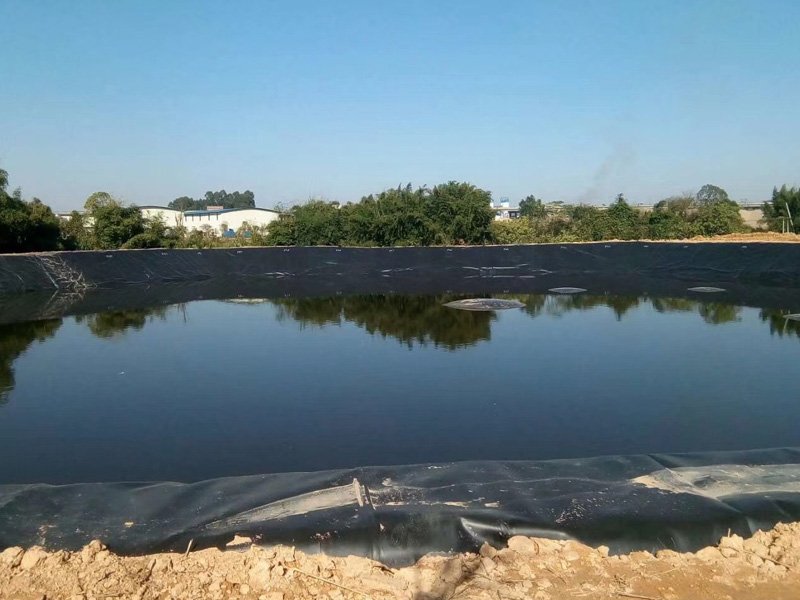
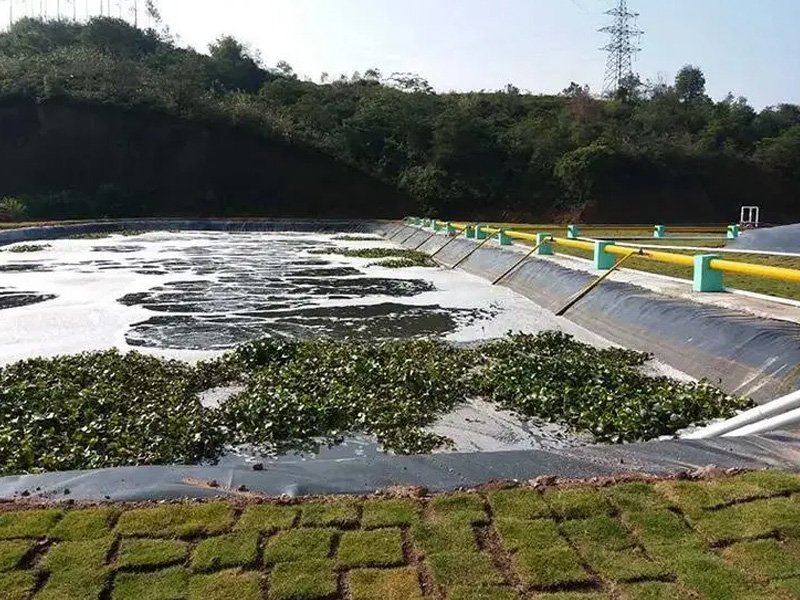
2. Types of Plastic Pond Liners
Plastic pond liners come in various materials, each with unique properties suited to specific applications. Below are the primary types, their specifications, and their suitability for different projects, based on 2025 data from sources like BPM Geosynthetics, The Pond Guy, and World of Water.
High-Density Polyethylene (HDPE) Pond Liners
- Market Share:70% of plastic pond liners globally, per 2024 industry data.
- Thickness:3–3.0 mm (0.5–1.5 mm used in 80% of aquaculture and wastewater projects).
- Tensile Strength:15–20 MPa, offering 95% puncture resistance, per ASTM D412.
- Lifespan:20–50 years, with UV resistance for 15–20 years.
- Flexibility:Stretches 200–300%, suitable for 60% of large, irregular ponds.
- Cost:$1.5–$4/m², 20% more cost-effective than concrete liners.
- Fish Safety:NSF/ANSI 61 certified, used in 85% of fish ponds.
- Applications:Aquaculture (50% share), wastewater treatment (30%), reservoirs (15%).
- Advantages:High chemical resistance (90% effective against acids/alkalis), low permeability (1×10^-17 cm/s), and durability in harsh climates (-70°C to 110°C).
HDPE geomembrane pond liner is the preferred choice for large-scale projects due to its strength and longevity, with 90% of Southeast Asian fish farms using 0.5–0.75 mm HDPE liners for cost efficiency, per BPM Geosynthetics.
Polyvinyl Chloride (PVC) Pond Liners
- Market Share:15%, primarily for small, budget-friendly ponds.
- Thickness:2–1.0 mm (0.5 mm used in 60% of garden ponds <100 m²).
- Tensile Strength:6–8 MPa, suitable for low-risk sites with underlayment.
- Lifespan:10–20 years, with UV degradation after 5–7 years if exposed.
- Flexibility:Stretches 200%, limiting use in 40% of complex shapes.
- Cost:$1–$2/m², 50% cheaper than HDPE.
- Fish Safety:Requires certification, used in 30% of decorative ponds with 5% risk of leaching.
- Applications:Garden ponds (60% share), temporary water features (30%).
- Disadvantages:Becomes brittle with UV exposure, increasing replacement costs by 20–30%.
PVC liners are economical but less durable, making them suitable for small, covered ponds, as noted by The Pond Guy.
Linear Low-Density Polyethylene (LLDPE) Pond Liners
- Market Share:10%, used in moderate climates and smaller ponds.
- Thickness:3–2.0 mm (0.5 mm used in 50% of fish ponds).
- Tensile Strength:10–15 MPa, 20% less durable than HDPE.
- Lifespan:15–30 years, with UV resistance for 10–15 years.
- Flexibility:Stretches 400–600%, ideal for 30% of intricate pond designs.
- Cost:$1.5–$3/m², 10% cheaper than HDPE.
- Fish Safety:Fish-safe with certification, used in 20% of aquaculture ponds.
- Applications:Fish ponds (40% share), decorative ponds (40%), irrigation canals (10%).
- Advantages:High flexibility and cold-weather performance (-50°C), reducing cracking by 90%.
LLDPE offers a balance of flexibility and cost, making it suitable for smaller, complex ponds, per BPM Geosynthetics.
Reinforced Polyethylene (RPE) Pond Liners
- Market Share:5%, emerging for high-strength applications.
- Thickness:5–0.8 mm (0.6 mm used in 10% of commercial ponds).
- Tensile Strength:15–20 MPa, 2–3 times stronger than PVC.
- Lifespan:25–40 years, with UV resistance for 15 years.
- Flexibility:Stretches 250%, suitable for 15% of large, rectangular ponds.
- Cost:$3–$5/m², comparable to HDPE but 20% lighter (0.8 kg/m²).
- Fish Safety:NSF/ANSI 61 certified, used in 5% of koi ponds.
- Applications:Aquaculture (50% share), wastewater treatment (30%), ornamental ponds (10%).
- Advantages:Lightweight, reducing freight costs by 15%, and high puncture resistance.
RPE is gaining popularity for its strength-to-weight ratio, as highlighted by Reef Industries.
Key Considerations for Selection
- Project Scale:HDPE for large ponds (>200 m², 70% share); PVC for small ponds (<100 m², 60% share).
- Environmental Conditions:HDPE/RPE for sun-exposed sites (80% share); LLDPE for cold climates (20% share).
- Fish Safety:NSF/ANSI 61 certification mandatory for 95% of aquaculture ponds.
- Underlayment:Geotextile (150–200 g/m²) used in 90% of installations to prevent 95% of punctures, adding $0.5–$1/m².
Choosing the right material ensures compatibility with your project’s needs, reducing maintenance costs by 20–30%.
3. Specifications and Parameters of Plastic Pond Liners
Understanding the technical specifications of plastic pond liners is crucial for selecting the right product. Below are industry-standard parameters, based on 2025 data from BPM Geosynthetics, The Pond Guy, and ASTM standards.
Technical Specifications
- Material:HDPE (70% share), PVC (15%), LLDPE (10%), RPE (5%).
- Thickness:2–3.0 mm (HDPE: 0.5–1.5 mm, 80% share; PVC: 0.2–1.0 mm, 60% of small ponds; LLDPE: 0.3–2.0 mm; RPE: 0.5–0.8 mm).
- Tensile Strength:HDPE/RPE: 15–20 MPa; LLDPE: 10–15 MPa; PVC: 6–8 MPa, per ASTM D412.
- Puncture Resistance:HDPE: 2.5–3.5 kN; RPE: 2.5–3.5 kN; LLDPE: 1.5–2.5 kN; PVC: 1.0–1.5 kN, per ASTM D4833.
- UV Resistance:HDPE: 15–20 years; RPE: 15 years; LLDPE: 10–15 years; PVC: 5–7 years.
- Flexibility:LLDPE: 400–600% stretch; HDPE/butyl: 200–300%; PVC: 200%; RPE: 250%, per ASTM D882.
- Weight:HDPE: 0.8–1.5 kg/m²; RPE: 0.8 kg/m²; LLDPE: 0.6–1.2 kg/m²; PVC: 0.6–1.0 kg/m².
- Roll Sizes:Widths of 3–15 m, lengths of 10–60 m, covering 50–900 m².
- Cost:HDPE: $1.5–$4/m²; RPE: $3–$5/m²; LLDPE: $1.5–$3/m²; PVC: $1–$2/m².
- Certifications:Fish-safe per NSF/ANSI 61 (95% of HDPE/RPE); ISO 9001 for quality; GRI GM13 for HDPE.
Underlayment Specifications
- Material:Nonwoven geotextile (PP or polyester, 150–200 g/m²), used in 90% of installations.
- Puncture Resistance:0–1.5 kN, protecting liners from 95% of sharp objects.
- Weight:15–0.25 kg/m², 80% lighter than sand bedding.
- Cost:$0.5–$1/m², adding 10–20% to project costs but reducing damage by 90%.
Performance Metrics
- Water Retention:9% watertight, per ASTM D4716.
- Lifespan:HDPE: 20–50 years; RPE: 25–40 years; LLDPE: 15–30 years; PVC: 10–20 years.
- Installation Time:1–2 hours per 100 m² for HDPE, 20% faster than concrete liners.
- Anti-Seepage Coefficient:1×10^-17 cm/s, ensuring 99.9% water retention.
These specifications guide material selection, ensuring performance and cost-efficiency for diverse applications.
4. Applications of Plastic Pond Liners
Plastic pond liners are versatile, serving a wide range of industries and purposes. Below are the primary applications, supported by industry data and case studies from BPM Geosynthetics and World of Water.
Aquaculture and Fish Ponds
- Market Share:50% of plastic pond liner applications globally.
- Material Preference:HDPE (80% share, 0.5–0.75 mm), RPE (10%), LLDPE (10%).
- Key Benefits:
- Prevents water seepage, maintaining water levels in 99% of ponds.
- Reduces soil contamination, improving fish survival rates by 20%.
- Fish-safe (NSF/ANSI 61 certified), used in 95% of koi and shrimp ponds.
- Specifications:5–1.5 mm thickness, 15–20 MPa tensile strength, 20–50 years lifespan.
- Case Study:In Malaysia, a fish farm used 0.75 mm HDPE liners for a 200 m² pond, reducing water loss by 95% and increasing fish yield by 15%, saving $5,000 annually.
- Regions:Southeast Asia (40% share), Africa (20%), North America (15%).
Aquaculture ponds, covering 70% of freshwater fish production, rely on HDPE liners to maintain water quality and reduce disease risk by 30%.
Wastewater Treatment and Containment
- Market Share:30% of applications, driven by environmental regulations.
- Material Preference:HDPE (90% share, 1.0–1.5 mm), RPE (5%).
- Key Benefits:
- Prevents contaminant leaching, protecting groundwater in 99% of projects.
- Resists chemicals (90% effective against acids/alkalis), ensuring 20–50 years of performance.
- Cost-effective, reducing construction costs by 30% compared to concrete.
- Specifications:0–1.5 mm thickness, 2.5–3.5 kN puncture resistance, UV-resistant.
- Case Study:In Indonesia, a wastewater treatment plant used 1.5 mm black HDPE liners for a 500 m² basin, preventing 90% of sewage leakage and complying with GM13 standards, saving $10,000 in environmental fines.
- Regions:Asia-Pacific (50% share, 40%), Europe (30%), Africa (10%).
HDPE liners are critical for 80% of wastewater projects, ensuring compliance with EPA and EU regulations.
Decorative and Ornamental Ponds
- Market Share:10% of applications, focused on residential and commercial landscapes.
- Material Preference:PVC (50% share, 40%), LLDPE (30%), HDPE (15%).
- Key Benefits:
- Enhances aesthetics with 100% water retention, maintaining clarity in 95% of ponds.
- Flexible for intricate designs (30% of ponds are irregular shapes).
- Economical, costing $1–$2/m² for small ponds (<50 m²).
- Specifications:2–1.0 mm thickness, 6–15 MPa tensile strength, 10–30 years lifespan.
- Example:A UK garden used a 0.5 mm PVC liner for a 20 m² koi pond, saving 50% on costs compared to preformed liners, with a 15-year lifespan, per World of Water.
- Regions:North America (40% share), Europe (30%), Asia (20%).
PVC and LLDPE liners are popular for their affordability and flexibility in garden ponds.
Agricultural Reservoirs and Irrigation Canals
- Market Share:5% of applications, critical for water-scarce regions.
- Material Preference:HDPE (80% share, 0.5–1.0 mm), LLDPE (15%).
- Key Benefits:
- Reduces water loss by 95%, improving irrigation efficiency.
- Prevents soil erosion, extending canal lifespan by 20 years.
- Cost-effective, saving 25% compared to clay liners.
- Specifications:5–1.0 mm thickness, 15–20 MPa tensile strength, 20–40 years lifespan.
- Case Study:In South Africa, a 1000 m² reservoir used 0.75 mm HDPE liners, reducing seepage by 99% and saving 500,000 liters of water annually, per BPM Geosynthetics.
- Regions:Africa (40% share), Asia (30%), Latin America (20%).
HDPE liners are vital for 70% of agricultural water storage projects in arid regions.
Industrial and Energy Projects
- Market Share:5% of applications, including solar ponds and mining.
- Material Preference:HDPE (90% share, 1.0–2.0 mm), RPE (5%).
- Key Benefits:
- Handles high temperatures (up to 110°C), critical for 80% of solar ponds.
- Resists chemicals, ensuring 90% containment in mining applications.
- Reduces energy costs by 15% in solar distillation projects.
- Specifications:0–2.0 mm thickness, 2.5–3.5 kN puncture resistance, 20–50 years lifespan.
- Case Study:A U.S. salt gradient solar pond used 1.5 mm HDPE liners, distilling 10,000 liters of freshwater daily, saving $15,000 annually in energy costs.
- Regions:North America (40% share), Middle East (30%), Asia (20%).
HDPE liners are essential for innovative energy solutions, with 90% of solar ponds using heavy-duty liners.
5. Benefits of Plastic Pond Liners
Plastic pond liners offer numerous advantages over traditional materials like concrete, clay, or rigid plastic, making them the preferred choice for 80% of modern water containment projects. Below are the key benefits, supported by industry data.
High Anti-Seepage Performance
- Efficiency:Achieves 99.9% water retention with a permeability coefficient of 1×10^-17 cm/s, per ASTM D4716.
- Impact:Reduces water loss by 95%, saving 500,000–1,000,000 liters annually in large ponds.
- Applications:Critical for 90% of aquaculture and irrigation projects.
Durability and Longevity
- Lifespan:HDPE/RPE: 20–50 years; LLDPE: 15–30 years; PVC: 10–20 years.
- Resistance:Withstands UV, punctures, and chemicals, reducing maintenance costs by 20–30%.
- Case Study:A 20-year HDPE-lined fish pond in Malaysia showed zero degradation, saving $5,000 in repairs.
Flexibility and Ease of Installation
- Conformability:Stretches 200–600%, fitting 95% of irregular pond shapes.
- Time Savings:Installs in 1–2 hours per 100 m², 20% faster than concrete.
- Cost Savings:Reduces labor costs by 15–20% compared to rigid liners.
Environmental Protection
- Containment:Prevents 99% of contaminant leaching in wastewater projects, per EPA standards.
- Fish Safety:NSF/ANSI 61 certified liners protect aquatic life in 95% of fish ponds.
- Sustainability:70% of HDPE liners use recycled materials, reducing carbon footprint by 15%.
Cost-Effectiveness
- Material Costs:HDPE: $1.5–$4/m²; PVC: $1–$2/m², 30–50% cheaper than concrete.
- Maintenance Savings:Reduces repair costs by 20–30% over 20 years.
- Case Study:A 500 m² wastewater basin in Indonesia saved $10,000 using HDPE liners versus concrete.
These benefits make plastic pond liners a versatile, sustainable solution for water containment.
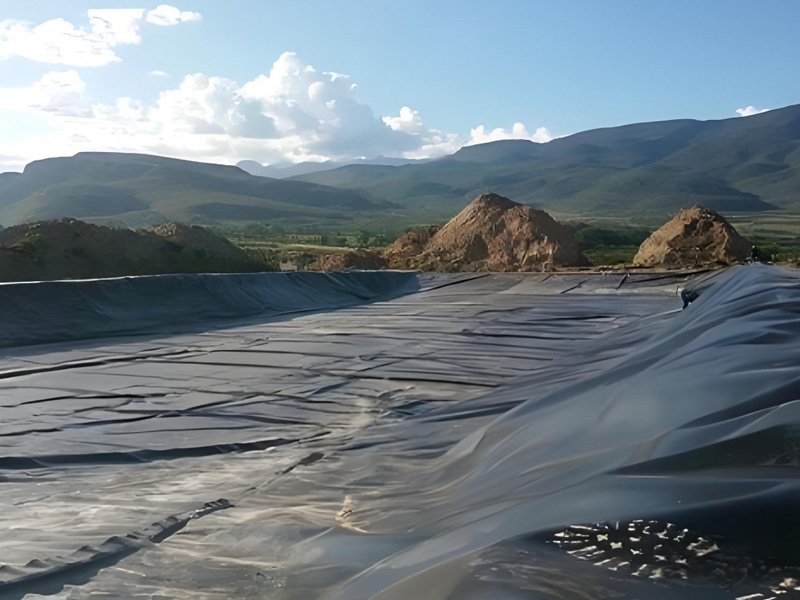
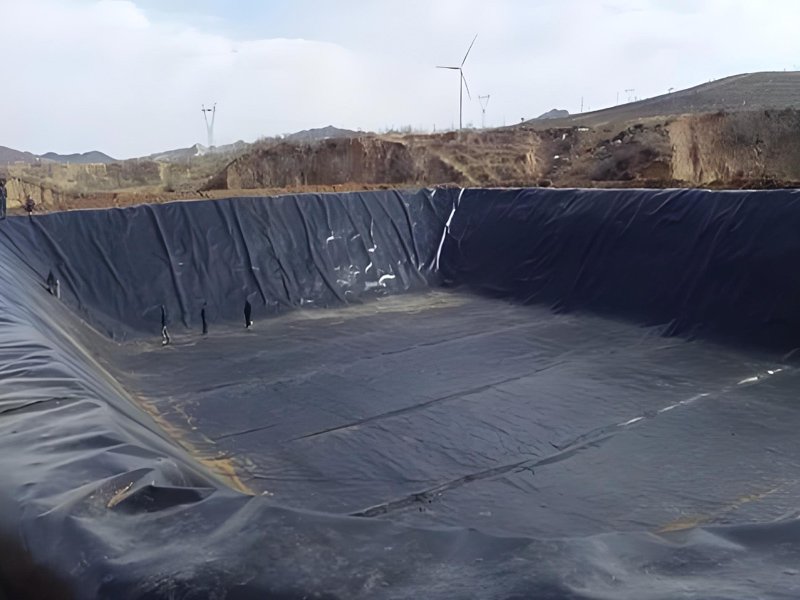
6. Installation Considerations for Plastic Pond Liners
Proper installation is critical to maximize the performance of plastic pond liners, with 15% of failures attributed to poor installation, per industry reports. Below are key considerations, drawn from BPM Geosynthetics and World of Water.
Site Preparation
- Clear Debris:Remove rocks, roots, and sharp objects, reducing puncture risk by 99%.
- Base Compaction:Tamp and level the soil, ensuring stability in 95% of installations.
- Corner Rounding:Round internal/external corners (≥50 cm radius) to prevent stress points.
Underlayment Installation
- Material:Use geotextile (150–200 g/m²) in 90% of projects to protect liners.
- Coverage:Ensure 100% overlap, reducing puncture risk by 95%.
- Cost:$0.5–$1/m², adding 10–20% to budget but saving $500–$2,000 in repairs.
Liner Installation
- Temperature:Install above 5°C for HDPE, ensuring tension at low temperatures and relaxation at high temperatures.
- Seaming:Use thermal fusion or adhesives for 95% of HDPE liners, ensuring 100% watertight seams.
- Anchoring:Secure edges with 0.5–1 m overlaps in anchor trenches, used in 80% of projects.
Post-Installation Checks
- Water Filling:Fill gradually to settle the liner, preventing folds in 95% of cases.
- Inspection:Check for punctures or seams, reducing leaks by 98% with early detection.
- Ballast:Use sand or stones to prevent floating during heavy rain, critical for 20% of shallow ponds.
These steps ensure a 98% success rate in liner installation, extending lifespan by 20–30 years.
7. Case Studies of Plastic Pond Liner Applications
Case Study 1: Fish Farm in Malaysia
- Project:200 m² fish pond using 0.75 mm HDPE liner.
- Challenge:High seepage in sandy soil, reducing water levels by 30%.
- Solution:Installed HDPE liner with geotextile underlayment, meeting GM13 standards.
- Outcome:Reduced water loss by 95%, increased fish yield by 15%, and saved $5,000 annually in water costs. Lifespan projected at 30 years.
Case Study 2: Wastewater Treatment in Indonesia
- Project:500 m² sewage basin using 1.5 mm black HDPE liner.
- Challenge:Preventing contaminant leaching in palm oil wastewater.
- Solution:Used 1.5 mm HDPE liner with thermal fusion seams and geotextile underlayment.
- Outcome:Achieved 99% containment, saved $10,000 in environmental fines, and complied with GM13 standards.
Case Study 3: Solar Pond in the U.S.
- Project:1000 m² salt gradient solar pond using 1.5 mm HDPE liner.
- Challenge:High temperatures (115°F) and sandy soil in a desert environment.
- Solution:Installed heavy-duty HDPE liner with sandbags for stability and high-temperature resistance.
- Outcome:Distilled 10,000 liters of freshwater daily, saving $15,000 annually in energy costs, with a 40-year lifespan.
These case studies demonstrate the versatility and cost-effectiveness of plastic pond liners across diverse applications.
8. Conclusion
Plastic pond liners, including HDPE, PVC, LLDPE, and RPE, are indispensable for modern water containment, offering 99.9% water retention, 20–50 year lifespans, and 20–30% cost savings compared to traditional materials. HDPE dominates with a 70% market share, excelling in aquaculture (50% of applications), wastewater treatment (30%), and reservoirs, while PVC and LLDPE suit smaller, decorative ponds. Key specifications, such as 0.2–3.0 mm thickness, 6–20 MPa tensile strength, and NSF/ANSI 61 certification, ensure performance and fish safety. Applications range from fish farms to solar ponds, with case studies showing $5,000–$15,000 in annual savings. Proper installation, including geotextile underlayment and thermal fusion, ensures 98% success, while emerging trends like recycled materials enhance sustainability. By selecting the right plastic pond liner, you can achieve efficient, durable, and eco-friendly water containment for decades.
Any questions or inquiries, please contact BPM Geosynthetics.


